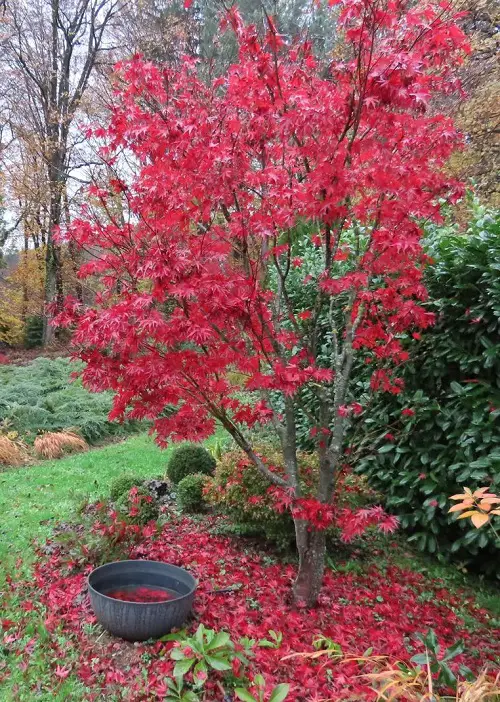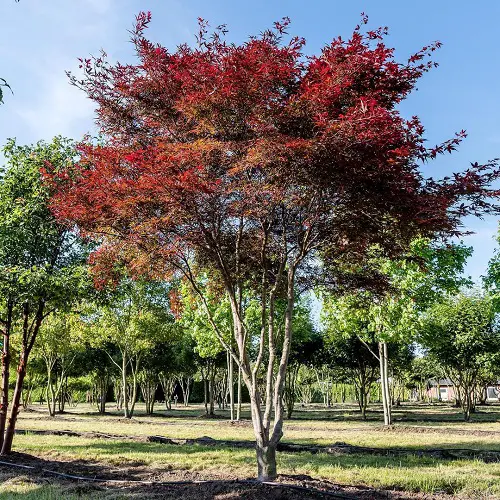It’s easy to get confused between the red foliage of Maple trees. Here’s a Japanese Maple Fireglow vs Bloodgood comparison to help you out!
We’ve got the best Japanese Maple Fireglow vs Bloodgood to help you tell these apart and care for them properly. Stay tuned!
Japanese Maple Fireglow (Acer palmatum ‘Fireglow’)

Japanese Maple Fireglow is a beautiful maple variety with fiery crimson foliage that turns deep purple in the summer. It’s native to Japan and Korea and easily grows 12-15 feet tall and wide.
It has a rounded and compact growth habit and needs little care. Just a bit of pruning, fertilizing, and full sun to part shade can help it grow into a beautiful tree. You can also grow it in a container.
What makes it better than all the other Japanese maples is its heat tolerance. It’s often confused with the Bloodgood variety because both of the species are actually cousins.
Bloodgood Japanese Maple (Acer palmatum ‘Bloodgood’)

Bloodgood Japanese Maples are also beautiful specimens with deep burgundy foliage that remains the same throughout the growing season. It’s slightly bigger, often reaching 15-20 feet in height, and has nearly the same care routine as its cousin.
What makes it stand out is its cold hardiness. It can tolerate temperatures as low as -29°C (-20°F), which makes it hardy down to zone 5.
Here’s How to Grow a Japanese Maple Tree in a Pot
Japanese Maple Fireglow vs Bloodgood: Similarities

As we’ve told you earlier, both of these trees are cousins so there are many similarities between the two.
- Species: Both of these belong to the same species and are cultivars of the Japanese maple species (Acer palmatum).
- Leaf Shape: They share the leaf shape as well; they have delicate leaves that are finely lobed. Bloodgood have deeper lobing, though.
- Soil Requirements: Fireglow and Bloodgood maples need moist, well-drained soil that is organically rich and just a teeny bit acidic.
Lilac vs Lavender: All the Differences
Japanese Maple Fireglow vs Bloodgood – Differences

1. Leaf Color
Fireglow have leaves that are pink-red in the spring and turn into a strong red in summer. On the other hand, the foliage of Bloodgood is reddish-purple in spring and maintains the same burgundy hue. It doesn’t change.
2. Leaf Texture
The shape of the leaves is the same in both trees, but Fireglow have smaller and more delicate leaves. Those of Bloodgood are a bit larger, and you’ll notice that they are thicker to touch.
3. Size
Fireglow are smaller in size and reach 12-15 feet in height and spread the same. Bloodgood grow slightly bigger and are 15-20 feet tall and wide.
4. Growth Habit
Fireglow Japanese Maples have a compact growth habit which is kind of rounded, perfect for containers and gardens. But that of Bloodgood Japanese Maples is upright.
5. Growing Zones
Fireglow are hardy to zones 5a-8b, and their cousins, Bloodgoods, are hardy to zones 5-8.
6. Container Gardening
You can easily grow Fireglow trees in containers, and they’ll keep thriving. However, maintaining a mature Bloodgood maple in a container is challenging so it’s better to grow it in the soil.
7. Fall Color Variations
When fall arrives, you’ll see the leaves of Fireglow maples slowly transitioning into an orange/yellow shade before dropping. And that of Bloodgood stays the same as most of the time; it holds onto that burgundy hue.



